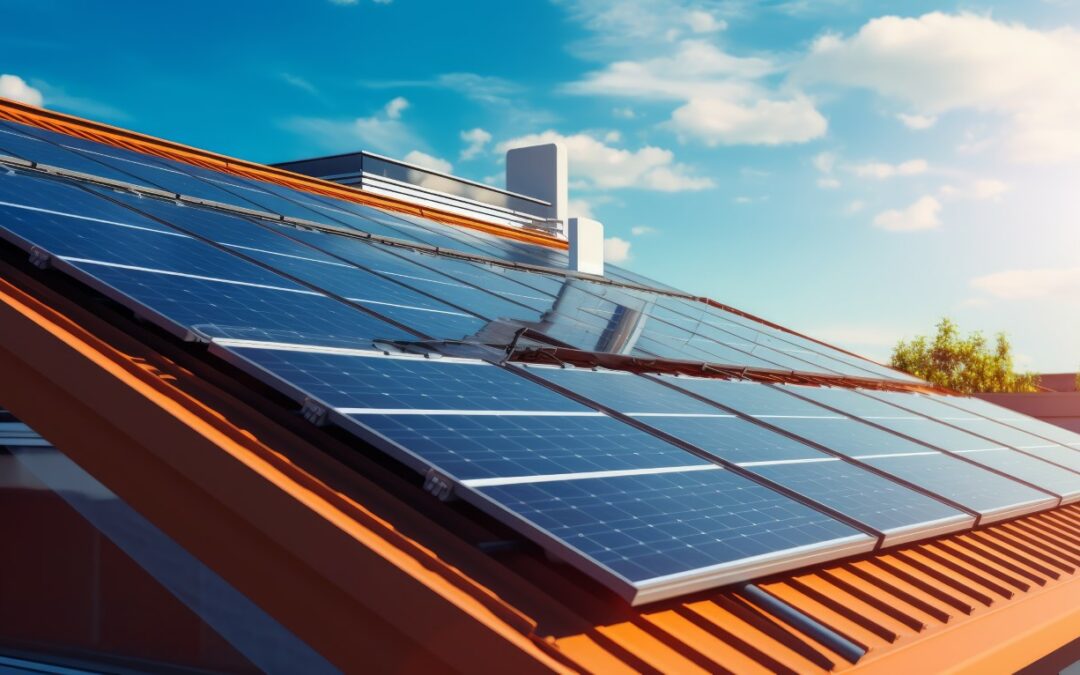Are you tired of skyrocketing energy bills and an uncomfortable home? Look no further! In this comprehensive guide, we bring you the top energy-saving roofing materials to transform your house into an eco-friendly haven.
From asphalt shingles to solar roofing, we’ve got you covered. With our expert insights and recommendations, you’ll be able to make informed decisions that not only save you money but also contribute to a greener planet.
Let’s embark on this energy-saving journey together!
Key Takeaways
- Asphalt shingles, metal roofing, clay tiles, and concrete tiles are affordable and durable roofing materials with long lifespans compared to asphalt roofs.
- Metal roofing and cool roofs are highly efficient options for energy-saving roofing, with high reflectivity reducing heat absorption and lowering cooling costs.
- Clay tiles and green roofs have excellent thermal insulation properties and long lifespans of up to 100 years, making them popular choices for environmentally conscious homeowners.
- Concrete tiles and solar roofing offer exceptional durability, minimal maintenance, and the ability to harness the power of the sun, reducing carbon footprint and energy costs.
Asphalt Shingles
Asphalt shingles are a popular choice for energy-saving roofing due to their affordability and durability. When it comes to the cost of installation, asphalt shingles are relatively inexpensive compared to other roofing materials, making them an attractive option for homeowners looking to save money.
Additionally, asphalt shingles have a long lifespan, typically lasting between 15 and 30 years, depending on the quality and maintenance. This means that once installed, homeowners can enjoy the benefits of energy-saving roofing for an extended period without worrying about frequent replacements or repairs.
The combination of cost-effectiveness and durability makes asphalt shingles a practical choice for individuals seeking a reliable and long-lasting roofing solution. With their energy-saving properties and reasonable price point, asphalt shingles provide a sense of belonging and security for homeowners who value both affordability and longevity in their roofing materials.
Metal Roofing
When considering energy-saving roofing materials, metal roofing stands out as a highly efficient option. Metal roofing types include steel, aluminum, copper, and zinc. Each type has its own set of benefits, making metal roofing a versatile and durable choice for homeowners.
One major advantage is its high reflectivity, which helps to reduce heat absorption and lower cooling costs in hot climates. Metal roofing also has a long lifespan, often lasting 50 years or more, and requires minimal maintenance. Additionally, it’s resistant to fire, rot, and insects, providing added peace of mind for homeowners.
With its energy-saving properties and long-term durability, metal roofing is a popular choice for those seeking a sustainable and cost-effective roofing solution.
Transitioning to the subsequent section about clay tiles, let’s now explore another energy-efficient option for roofing.
Clay Tiles
Moving on from metal roofing, let’s now delve into the benefits of clay tiles as an energy-saving roofing material.
Clay tiles have gained popularity in the construction industry due to their numerous advantages. One of the key benefits of clay tiles is their energy-saving properties. These tiles possess excellent thermal insulation capabilities, helping to keep the interior of a building cool during hot summers and warm during cold winters.
Additionally, clay tiles are known for their durability and longevity, with a lifespan of up to 100 years. The installation process of clay tiles involves interlocking the tiles and securing them to the roof structure. This method ensures a tight fit that prevents leaks and enhances energy efficiency.
With their energy-saving benefits and reliable installation process, clay tiles are an excellent choice for environmentally conscious homeowners seeking long-lasting roofing solutions.
Concrete Tiles
Concrete tiles are an excellent option for energy-efficient roofing due to their high thermal mass, which helps regulate indoor temperatures and reduce the need for excessive heating or cooling.
Additionally, concrete tiles are known for their exceptional durability, making them a long-lasting roofing material that requires minimal maintenance.
With their energy-saving properties and longevity, concrete tiles are a practical choice for homeowners looking to reduce their carbon footprint and save on energy costs.
Energy Efficiency of Concrete
In our comprehensive guide on top energy-saving roofing materials, let’s now delve into the energy efficiency of concrete tiles.
When comparing concrete to asphalt roofs, concrete proves to be much more efficient. Concrete roofs have a higher thermal mass, which means they can absorb and store heat during the day, and release it slowly at night. This helps regulate indoor temperatures and reduces the need for excessive heating or cooling.
Additionally, concrete tiles have excellent insulation properties, reducing heat transfer from the outside to the inside of a building. Concrete roofs also have a longer lifespan compared to asphalt roofs, which reduces the need for frequent replacements and associated energy consumption.
Durability of Concrete
Continuing our exploration of concrete tiles, let’s examine their impressive durability.
Concrete tiles are known for their exceptional long-term performance and resilience. These tiles are designed to withstand harsh weather conditions, including high winds, heavy rain, and extreme temperatures.
Their strong composition and sturdy structure make them highly resistant to cracking, breaking, and warping, ensuring that they can endure for many years without compromising their functionality.
In terms of maintenance requirements, concrete tiles are relatively low-maintenance. They don’t require frequent repairs or replacements, saving homeowners both time and money in the long run. Regular cleaning and inspections are recommended to maintain their appearance and ensure their performance remains optimal.
With proper care, concrete tiles can provide a reliable and durable roofing solution that will last for decades.
Cool Roofs
Our research has found that many homeowners are turning to cool roofs for their energy-saving benefits. Cool roof technology utilizes materials and designs that reflect more sunlight and absorb less heat compared to traditional roofs. This helps to reduce the amount of heat transferred into the building, leading to lower cooling costs and increased energy efficiency.
Cool roof installation involves applying reflective coatings or using reflective roofing materials such as tiles, shingles, or metal sheets. These roofs can help to mitigate the urban heat island effect and improve the comfort levels inside buildings. Additionally, cool roofs can have a positive impact on the environment by reducing carbon emissions and lowering the electricity demand.
Now, let’s move on to the next section and explore the benefits of green roofs.
Green Roofs
Green roofs offer numerous environmental benefits, making them a popular choice for energy-saving roofing. The vegetation and soil on green roofs help to reduce the urban heat island effect, lower air temperatures, and improve air quality. Additionally, green roofs can be cost-effective in the long run by reducing energy consumption and extending the lifespan of the roof membrane.
Environmental Benefits of Green Roofs
With the implementation of green roofs, we can maximize the environmental benefits of our roofing materials. Green roofs, also known as vegetated roofs, offer a range of advantages that contribute to a more sustainable and eco-friendly built environment.
One of the key benefits of vegetation on roofs is improved stormwater management. Green roofs absorb and retain rainwater, reducing the amount of runoff that enters stormwater systems. This helps to alleviate the strain on urban drainage infrastructure and prevent flooding. Furthermore, green roofs act as natural filters, removing pollutants and contaminants from rainwater before it enters waterways.
Cost-Effectiveness of Green Roofs
Maximizing the environmental benefits of green roofs, we can now explore the cost-effectiveness of implementing this sustainable roofing solution. Green roofs have a longer life span compared to traditional roofs, which helps to offset the initial investment. While the upfront costs of installing a green roof may be higher, the long-term savings can be significant.
Green roofs provide insulation, reducing energy consumption for heating and cooling. This leads to lower utility bills and a higher return on investment over time.
Additionally, green roofs can extend the life span of the roof membrane by protecting it from UV radiation and extreme temperatures. This reduces maintenance and replacement costs.
Overall, the cost-effectiveness of green roofs makes them a smart choice for those looking to save money while also benefiting the environment. Now, let’s transition to the next section on solar roofing.
Solar Roofing
We can achieve significant energy savings by harnessing the power of the sun with solar roofing. Solar roofing involves the integration of solar panels into the roof of a building, allowing it to generate electricity from sunlight.
This innovative technology not only reduces our dependence on traditional energy sources but also helps to lower our carbon footprint. Solar panel integration is a key feature of solar roofing, ensuring that the panels are seamlessly integrated into the roof’s design and structure. This integration maximizes the efficiency of the panels and allows them to generate the most energy possible.
In terms of maintenance requirements, solar roofing is relatively low maintenance. Regular cleaning and inspections are necessary to ensure optimal performance, but overall, solar roofing is a cost-effective and sustainable option for energy savings.
Conclusion
In conclusion, when it comes to energy-saving roofing materials, there are several options to consider. From asphalt shingles to metal roofing, clay tiles to cool roofs, each offers unique benefits in terms of energy efficiency.
However, one material that stands out is solar roofing. Harnessing the power of the sun, solar roofing not only provides insulation but also generates electricity, making it a sustainable and cost-effective choice for environmentally conscious homeowners.
Embrace the future of roofing and start saving energy today with solar roofing.

